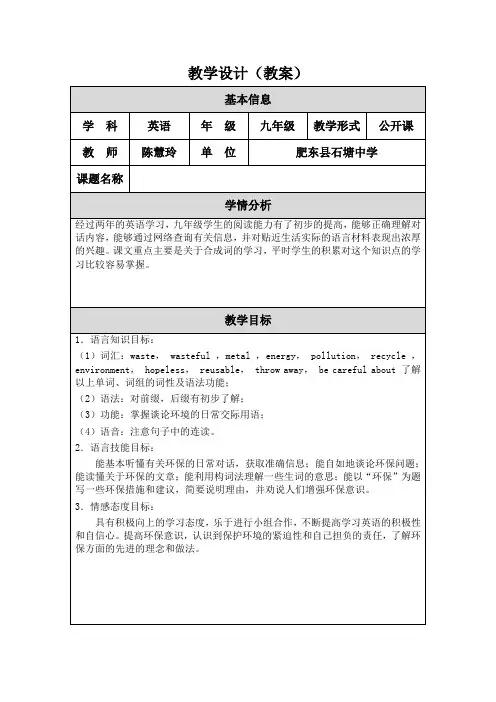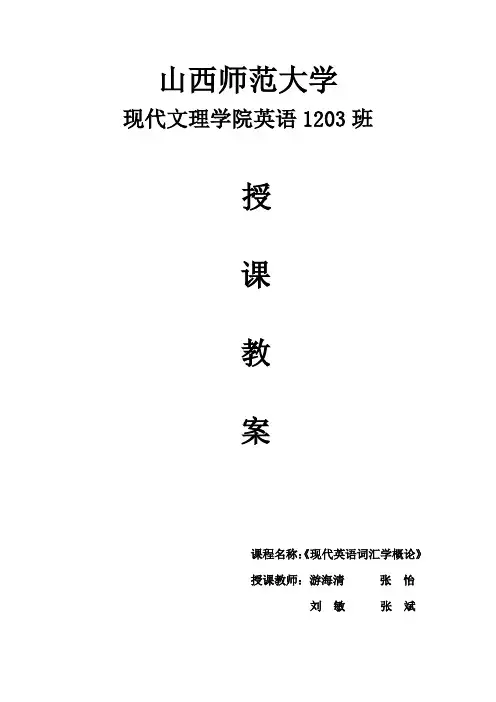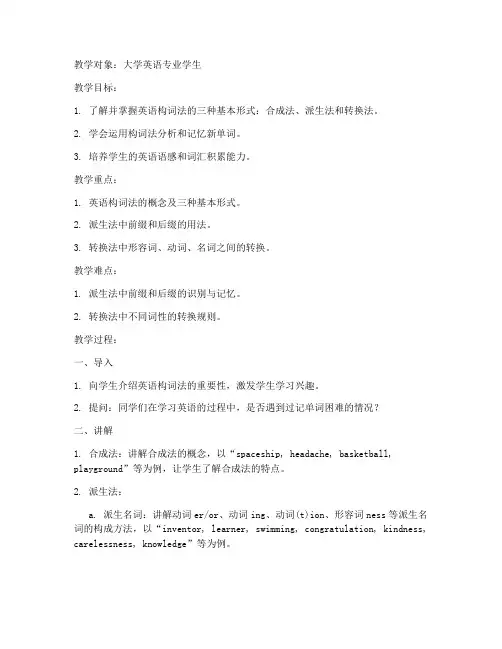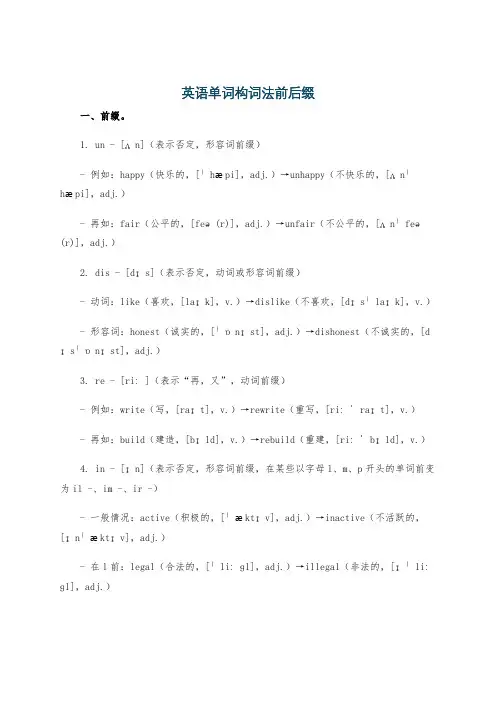英语单词常见前后缀总结学习教案
英语教学设计

[学生在教学过程中始终处于主体地位,是学习的参与者;教师在教学过程中注意观察学生的表现,鼓励他们大胆参与语言实践。]
2.)Listen to the tape and review the words in this unit
Step 4. Listening and read
教学目标
1.语言知识目标:
(1)词汇:waste,wasteful,metal,energy,pollution,recycle,environment,hopeless,reusable,throw away,be careful about了解以上单词、词组的词性及语法功能;
(2)语法:对前缀,后缀有初步了解;
[设计的活动既突出互动合作,又体现个性化发展;活动的主题难易顾及到学生的实际情况,操作具有可行性;教师导演,学生主演,充分发挥学生的主体作用和积极能动性,真正体现了“以人为本”的任务型语言教学模式。]
Step 7、Consolidation and sum-up
由学生总结所学内容。
[让学生来做课堂小结,抓住了学生“敢于开口说英语”的心理,突出主动学习的重要性。]
板书设计
Module6 Save our world
Unit1 It’s wasteful to throw away paper and metal.
Words:
enjoy-enjoyable
environment-environmental
care-careful
waste-wasteful
use-reusable
(3)功能:掌握谈论环境的日常交际用语;
(4)语音:注意句子中的连读。
学习构词法教案

学习构词法教案一、教学目标1. 掌握构词法的基本概念和常见的构词方法;2. 能够通过构词法对词汇进行扩充和应用,提高写作和阅读能力;3. 培养学生对词汇的敏感度和积极的学习态度。
二、教学重点1. 掌握构词法的基本概念;2. 熟练运用常见的构词方法。
三、教学难点1. 学生对构词法的理解和应用;2. 学生的写作能力的提高。
四、教学准备1. 教材:《英语构词法教程》;2. 多媒体设备。
五、教学过程Step 1 引入1. 教师出示一些词汇,如:teach、happy、child等;2. 鼓励学生思考这些词汇的构成方式,并引导学生探讨构词法的作用。
Step 2 构词法基础知识讲解1. 教师介绍构词法的基本概念和作用;2. 教师讲解常见的构词方法,如前缀、后缀、派生、合成等,并通过例子进行说明;3. 引导学生思考不同的构词方法对词义的影响。
Step 3 练习与巩固1. 教师出示一些词汇,如:careful、unhappiness、childhood等;2. 学生根据所学构词法方法,分析这些词的构成并解释词义;3. 学生分组互相讨论并交流结果。
Step 4 创设情景,提高应用能力1. 教师设计一些情境,如描述动物的特征、谈论环境问题等;2. 学生运用所学构词法方法,尝试扩展相关的词汇,并运用到情境中;3. 学生展示自己的构词成果。
Step 5 拓展与应用1. 学生自主阅读一篇文本,辨认其中的构词成分;2. 学生通过构词法分析,理解并记忆文章中的生词;3. 学生尝试在写作中运用所学构词法方法,丰富自己的表达。
六、课堂小结通过本节课的学习,学生初步了解了构词法的基本概念和常见的构词方法,并能够运用构词法对词汇进行扩展和应用。
同时,学生的写作和阅读能力也得到了一定的提高。
七、作业布置1. 阅读相关文章,并标记出文中的构词成分;2. 撰写一篇关于环境问题的文章,并尝试运用所学的构词法方法。
八、教学反思通过本节课的教学,学生对构词法的理解和应用有了初步的认识,并且能够在实际的写作和阅读中进行运用。
词汇学 第三章

山西师范大学现代文理学院英语1203班授课教案课程名称:《现代英语词汇学概论》授课教师:游海清张怡刘敏张斌构词法教案课题: WORD-FORMATION(I)授课教师:游海清教材:现代英语词汇学概论第 3 章第 1-4 节P 31 ~P 71一、教学目标:1、知识目标:a.了解构词法的一些基本知识和观点b.明确合成法的定义c.掌握合成法的分类d.了解派生法及转化法的定义e.熟练掌握派生法及转化法的分类f.明确常见前后缀的词义2、能力目标:a.提升学生记忆单词的能力b.理解构成的新词的意义c.扩大词汇量,提升阅读水平二、教学重点:合成法派生法转化法三、教学难点:转化法四、教学方法:讲授法问答法 PPT演示练习法课堂讨论法对比法五、教具仪器:多媒体粉笔教案教材六、授课提纲:七、教学内容详析第一节General remarks 第一步:T:OK,class,let’s begin.How many processes of word-formation do you know ?Do you know differences between root,stem and base?第二步:A.percentage of new wordspounding or composition(about 27%)B.Derivation or affixation(about 17.5%)C.Conversion(about 10.5%)A.initialisms and acronyms(about 9%)B.Blending(about 6%)C.Clipping(about 2%)D.Words from proper names(about 2%)E.Back formation(about 1%)F.Reduplication(about 0.5%)G.Neo-classical formations(about 4%)H.Others (about 3%)B.Some basic concepts of word-formation1.The differences between “root”, “stem” and “base”?Root/ 词根: is not further analyzable, either in terms of derivational or inflectional morphologyStem/ 词干: the part of the word-form which remains when all inflectional affixes have been removed.Base/ 词基: any form to which affixes of any kind can be added.举例:1)undesirables= un + desire + able + sBase:desirable→ desire (base)undesirable→ desirable (base)undesirables→ undesirable (base)Base/词基: any form to which affixes of any kind can be added.分析:desirable: desire(root or base, not stem)undesirable: desirable(base, not root, not stem)undesirables: undesirable(stem or base, not root)desired: desire(root, stem or base)第三步:1)denationalizeddenationalized = de + nation + al + ize + dRoot:nationStem:denationalizeBase:national→ nationnationalize→ nationaldenationalize→ nationalizedenationalized→ denationalize2)Uncomfortable=un +comfort+ableRoot: comfortStem:uncomfortableBase:comfortable第二节:Compounding第一步:板书下列单词1.noun compoundsHeadache heartbeat crybabyPickpocket birthcontrol housekeeping2.adjective compoundsThunder-struck weather-beaten suntannedFault-finding peaceloving record-breaking3.verb compoundsHouse-keep ghost-write aircondition mass-produce第二步:A.DefinitionCompounding / composition: a word-formation process consisting of joining two or more bases to form a new unit.e.g.flowerpot= flower + potmachine-independent= machine + independentThe relative criteria of a compound 1) Orthographic criterion:Compounds are written in three ways, that is, solid,hyphenated and open.E.g. flowerpotSolid: flowerpotHyphenated: flower-pot Open: flower pot2) Phonological criterion:C ompound accent: a main stress on the first element andsecondary stress on the second element.Normal phrase accent: a secondary stress on the firstelement and the main stress on the second element.E.g.black listblackboardblue bottle3) Semantic criterion:Semantically, compounds can be said to have a meaning whichmay be related to but cannot always be inferred from the meaningB.Classification1)noun compoundsA.Subject and verbB.verb and objectC.verb and adverbialD.subject and objectE.restrictive relationF.appositive relation2)adjective compoundsA.subject and verbB.verb and objectC.verb and adverbialD.noun and adjectiveE.coordinating relationship3)verb compoundsA.back-formationB.Conversion第三步:做P66-P67练习第三节 Derivation第一步:T:OK,class,let’s begin.Un-uncomfortable unimportant unclean unable unclear unknown Unlike uncertainIm-impossible impatient impair impracticable impolite imbalance immoral impartial impassive imprisonDis-dislike dismiss disclose disrupt disabuse disadvantage disable discharge display disagreeEr(or)-actor teacher doctor driver writer rider commander worker traveller collector farmer cooker baker stranger foreignerAble-actionable companionable comfortable disable livable reliable accountable reasonable fashionable impressionable Ize-civilize symbolize realize naturalize socialize characterize revolutionize materialize第二步:A.definition:Derivation / affixation: a process of forming new words by the addition of a word element, such as a prefix, suffix or combining form, to an already existing word.e.g.recover= re + coverworker= work + erB.classification(一)Prefixation: adding a prefix or combining form to the base.do not generally alter the word-class of the base.1)classification of prefixes1. negative prefixes (反意前缀): un-, non-, in-(im-, il-, ir-), dis-, a-2. reversative / privative prefixes(相反动作前缀): un-, de-, dis-,3. pejorative prefixes (贬义前缀): mis-, mal-, pseudo-4. prefixes of degree or size(等级与大小前缀): arch-, super-, out-, sub-, over-, under-, hyper-, altra-, mini-5. prefixes of attitude(态度取向前缀): co-, counter-, anti-, pro-6. locative prefixes(方位前缀): super-, sub-, inter-, trans-7. prefixes of time and order(时间顺序前缀): for-, pre-, post-, ex-, re-8. number prefixes(常用数字前缀): uni-/mono-, bi-/di-, tri, multi-/poly-9. miscellaneous prefixes: auto-, neo-, pan-, proto-, semi-, vice- 1.2)brief description of some productive prefixes in current English1. ant- / anti-Anti-Japanese War抗日战争ant- / anti-: unlike tradition2.de-A.to undo or reverse .Eg: decentralize decolonize denationalizeB.to removeEg: defog debug delocalize denuclearize3.mini-A.very smll size,duration,or importanceEg: minibus minibike minicab miniparkB.shortEg: minidress miniskirt minicoat minisuit4.un-A.not,the opposite ofEg: unkind unsee unbendingB.reverse the actionEg: unpack untieC.release from or to deprive ofEg: unleash unhorse(二)Suffixation: suffixation is the formation of a new word by adding a suffix or a combining form to the base, and usually changing the word-class of the base.1)classification of suffixes1.noun suffixes:2.Verb suffixes:3.Adjective suffixes:4.Adverb suffixes:2)brief description of some productive suffixes in current English.1.-able2.-er(or)3.-in4.-ish5.-ize6.-y3)differentiating suffixesEg:-ic and -ical第三步:引导学生口头总结第四节conversion第一步:绕口令1.never trouble trouble till trouble troubles you2.Can you can a can as a canner can can a can 你能像罐头工人那样把罐头装进罐头盒子里吗?3.I wish to wish the wish you wish to wish,but if you wish the wish the witch wishes,i won’t Wish the wish you wish to wish 我愿许你所许,若你的愿望太过虚幻不切实际,我就不会许你所许(我就不会和你一起天真的去幻想了第二步:A.introductory remarks1 )Conversion is a word-formation process whereby a word ofa certain word-class is shifted into a word of another word-class without the addition of an affix.functional shift:concerned with usage only not with word-formation derivation by zero suffix:long and cumbersome; clarify only something minor, not crucial2)conversion as a result of the almost entire loss of inflection in modern English.B.tapes of conversion1.noun→verb conversion(a) to put in/on N.The workers canned apples.put apples in cansThis room was floored with titles.cage birdsThe question certainly cornered me.He pocketed his wallet.(b) to give / provide N.They sheltered the orphans.give shelter to the orphanspills coated with sugarsugared pillsThe bottle is labeled poison.The child rose from the ground plastered over with yellow clay.(c) to remove N.Bill weeded the garden.cut off weeds in the gardencore an applepeel an orangedust a cap(d) to do sth. with N.John braked the car.stopped the car with a brakescrew the two pieces togetherelbow one’s way through the crowd(e) to act as N.She mothered the orphan. (human n.)looked after the orphan like a motherTom parroted what the boss had said. (animal n.)repeat sth. like a parrotThe police shadowed the suspected spy. ( inanimate n.) follow the spy closely like a shadow(f) to make / change sth. into N.(g) to send sth. / go by N.(h)to spend the period of time denoted by N.2.verb→noun conversion(a) He had a desire to be a scientist.desired to be a…state of mind / sensation(b) His usual morning commute to workan act of commuting event /activitydynamic verbsThis kind of nouns usually occur following verbs like give, have, make, or take, and are preceded by the indefinite article.(c) This little restaurant is quite a find.sth. found, esp. sth. valuable or pleasingobject or result of v.(d) He is a great bore.He is a person who bores everyone.agent of v.(e) The cloth is a good cover for the table.I covered the table with a cloth.instrument of v.3.adjective→verb conversion(a) pale, slim, sourto become the adj.(b) free, warm, smoothto cause sb. / sth. to become the adj.4.adjective→noun conversion(a) Partial conversionthe poorthe Scotch / the Japanesethe roughthe latest / his bestthe accused(b) Complete conversionHe is a natural for the job.Tom is one of our regulars.5.Other conversions第三步:布置作业八、预期效果学生能熟练运用合成法、派生法、转化法以及掌握由三大构词法构成的新词的意义。
英语单词常见前后缀总结衔接教学

misguided 误入歧途的
1 in-(不,非) invisible看不见的; incomplete 不完全的 more examples: inactive; incorrect; 2 il illegal 不合法的 ; illogical; 不合逻辑的 more examples:
ill-timed
不合逻辑的 不道德的 不可抗拒的
否 un-(不,非) unfair 不公平的
unhealthy 不健康的
定 non-(无,没有) nonsense 无价值的东西 前 缀 dis-(不,无) disagree 不同意
noneffective 无效力的;无战 斗力的
disadvantage 劣势,缺点
mis-(误解,坏) misunderstand 误解
overdeveloped 过度发达,发育过度;
2. 表示其他意义的前缀常用的有a-(多构成标语形容词), anti-(反对;抵抗), auto-(自动), co-(共同), en-(使), inter-(互相), re-(再;又), sub-(下面的;次), tele-(距离)等。 Eg: Large parts of the city had to be rebuilt. rebuild动词,前缀re(重新)+词根build(建造) rebuild(重建)。
前缀 prefix
前缀
例词
in-(不,非) invisible 看不见的
incomplete 不完全的
il-(不,非)
常 见
im-(不,非)
的 ir-(不,非)
illegal 不合法的
illogical
imperfect 不完善的,不完美的 immoral
英语语法构词法教案大学

教学对象:大学英语专业学生教学目标:1. 了解并掌握英语构词法的三种基本形式:合成法、派生法和转换法。
2. 学会运用构词法分析和记忆新单词。
3. 培养学生的英语语感和词汇积累能力。
教学重点:1. 英语构词法的概念及三种基本形式。
2. 派生法中前缀和后缀的用法。
3. 转换法中形容词、动词、名词之间的转换。
教学难点:1. 派生法中前缀和后缀的识别与记忆。
2. 转换法中不同词性的转换规则。
教学过程:一、导入1. 向学生介绍英语构词法的重要性,激发学生学习兴趣。
2. 提问:同学们在学习英语的过程中,是否遇到过记单词困难的情况?二、讲解1. 合成法:讲解合成法的概念,以“spaceship, headache, basketball, playground”等为例,让学生了解合成法的特点。
2. 派生法:a. 派生名词:讲解动词er/or、动词ing、动词(t)ion、形容词ness等派生名词的构成方法,以“inventor, learner, swimming, congratulation, kindness, carelessness, knowledg e”等为例。
b. 派生形容词:讲解名词y、名词ful、动词ing/ed等派生形容词的构成方法,以“snowy, sunny, hopeful, beautiful, interesting, following, daily, nervous, delicious”等为例。
c. 派生副词:讲解形容词ly、其他等派生副词的构成方法,以“slowly, angrily, fullfully, goodwell, possiblepossibly”等为例。
3. 转换法:a. 形容词动词:讲解形容词转换为动词的规则,以“dry, clean”等为例。
b. 动词名词:讲解动词转换为名词的规则,以“look, walk, rest, work, study, swim, go, talk”等为例。
英语单词构词法前后缀

英语单词构词法前后缀一、前缀。
1. un - [ʌn](表示否定,形容词前缀)- 例如:happy(快乐的,[ˈhæpi],adj.)→unhappy(不快乐的,[ʌnˈhæpi],adj.)- 再如:fair(公平的,[feə(r)],adj.)→unfair(不公平的,[ʌnˈfeə(r)],adj.)2. dis - [dɪs](表示否定,动词或形容词前缀)- 动词:like(喜欢,[laɪk],v.)→dislike(不喜欢,[dɪsˈlaɪk],v.)- 形容词:honest(诚实的,[ˈɒnɪst],adj.)→dishonest(不诚实的,[d ɪsˈɒnɪst],adj.)3. re - [riː](表示“再,又”,动词前缀)- 例如:write(写,[raɪt],v.)→rewrite(重写,[riːˈraɪt],v.)- 再如:build(建造,[bɪld],v.)→rebuild(重建,[riːˈbɪld],v.)4. in - [ɪn](表示否定,形容词前缀,在某些以字母l、m、p开头的单词前变为il -、im -、ir -)- 一般情况:active(积极的,[ˈæktɪv],adj.)→inactive(不活跃的,[ɪnˈæktɪv],adj.)- 在l前:legal(合法的,[ˈliːɡl],adj.)→illegal(非法的,[ɪˈliːɡl],adj.)- 在m前:moral(道德的,[ˈmɒrəl],adj.)→immoral(不道德的,[ɪˈm ɒrəl],adj.)- 在r前:regular(规则的,[ˈreɡjələ(r)],adj.)→irregular(不规则的,[ɪˈreɡjələ(r)],adj.)5. pre - [priː](表示“在……之前”,形容词或动词前缀)- 形容词:school(学校,[skuːl])→preschool(学前的,[ˈpriːskuːl],adj.)- 动词:pay(支付,[peɪ],v.)→prepay(预付,[priːˈpeɪ],v.)6. post - [pəʊst](表示“在……之后”,形容词或名词前缀)- 形容词:war(战争,[wɔː(r)])→post - war(战后的,[ˈpəʊst wɔː(r)],adj.)- 名词:graduate(毕业生,[ˈɡrædʒuət])→postgraduate(研究生,[ˌp əʊstˈɡrædʒuət],n.)二、后缀。
速记单词初中课程教案
速记单词初中课程教案课时:2课时年级:初中一年级教学目标:1. 让学生掌握常用的单词记忆技巧,提高单词记忆效率。
2. 培养学生积极学习英语的兴趣,增强自信心。
3. 通过速记单词,提高学生的英语词汇量。
教学内容:1. 单词记忆技巧讲解2. 单词速记练习3. 单词应用游戏教学过程:第一课时:一、导入(5分钟)1. 老师以提问方式引导学生回顾已学过的单词,激发学生的学习兴趣。
2. 讲解本节课的教学目标和方法。
二、单词记忆技巧讲解(15分钟)1. 讲解音标记忆法:通过单词的发音特点,记住单词的拼写。
2. 讲解构词法:通过词根、前缀、后缀等构成单词的方法,扩大词汇量。
3. 讲解联想记忆法:通过联想单词的形状、意义、用法等,加深对单词的记忆。
三、单词速记练习(15分钟)1. 老师出示一组单词,要求学生在规定时间内记住这些单词。
2. 学生进行速记练习,老师巡回指导。
3. 学生分享自己的速记方法,互相学习。
四、单词应用游戏(10分钟)1. 老师组织学生进行单词接龙游戏,巩固所学单词。
2. 学生积极参与,提高英语实际运用能力。
第二课时:一、复习导入(5分钟)1. 老师以提问方式检查学生对上一节课所学单词的记忆情况。
2. 讲解本节课的教学目标和方法。
二、单词记忆技巧讲解(15分钟)1. 讲解分类记忆法:将单词按照主题、词性等进行分类,便于记忆。
2. 讲解地图记忆法:通过单词在地图上的位置,记住单词的意思。
3. 讲解故事法:通过编写故事,将单词融入其中,加深记忆。
三、单词速记练习(15分钟)1. 老师出示另一组单词,要求学生在规定时间内记住这些单词。
2. 学生进行速记练习,老师巡回指导。
3. 学生分享自己的速记方法,互相学习。
四、单词应用游戏(10分钟)1. 老师组织学生进行单词拼写比赛,提高学生的单词记忆能力。
2. 学生积极参与,提高英语实际运用能力。
五、总结与布置作业(5分钟)1. 老师对本节课的内容进行总结,强调单词记忆的重要性。
《angengingong》公开课的教案
《angengingong》公开课的教案一、教学内容本节课选自《英语课程标准》第三册第五章,具体内容包括ang, eng, ing, ong四个后缀音节的认读和拼写。
通过本节课的学习,学生将掌握ang, eng, ing, ong的发音规律,能够在单词中正确拼读和书写。
二、教学目标1. 知识与技能:学生能够正确认读和拼写ang, eng, ing, ong音节,并能在实际单词中运用。
2. 过程与方法:通过实践情景引入、例题讲解、随堂练习等方式,培养学生自主探究、合作交流的能力。
三、教学难点与重点重点:ang, eng, ing, ong音节的认读和拼写。
难点:区分ang, eng, ing, ong音节在不同单词中的发音。
四、教具与学具准备教具:PPT、卡片、黑板、录音机。
学具:单词卡片、练习册、彩色笔。
五、教学过程1. 导入(5分钟)a. 利用PPT展示含有ang, eng, ing, ong音节的图片,引导学生观察和猜测。
2. 新课呈现(15分钟)a. 教师通过PPT和卡片,展示ang, eng, ing, ong音节的例词,引导学生跟读和模仿。
b. 学生自主拼读和书写相关音节,教师巡回指导。
3. 例题讲解(10分钟)a. 教师挑选几个具有代表性的例题,详细讲解解题思路。
b. 学生跟随教师一起完成例题,巩固所学知识。
4. 随堂练习(15分钟)a. 教师发放练习册,学生独立完成。
b. 教师挑选部分学生进行答案分享,并对错误答案进行纠正和解析。
5. 小组合作(5分钟)a. 学生分组,每组挑选一个ang, eng, ing, ong音节,设计一个单词接龙游戏。
b. 各小组展示游戏成果,其他同学进行评价。
a. 教师对本节课所学内容进行简要回顾。
b. 学生分享学习心得,教师给予鼓励和指导。
六、板书设计1. 板书课题:《ang, eng, ing, ong音节的认读和拼写》2. 板书内容:a. ang, eng, ing, ong音节及其例词。
英语前后缀归纳(详细版)
前缀:一、表示否定的前缀1、dis-加在名词、形容词和动词之前:disadvantage(缺点)、dishonorable(不光彩的)、disagree(不同意的)2、in-加在形容词和名词之前:incorrect(不正确的)、inability(无能、无力)inaccurate(不准确的)3、im-加在字母m,b,p之前:impossible(不可能的)、impolite(不礼貌的)、impudence(厚颜无耻的)4、il-加在以l开头的词之前:illegal(非法的)illiterate(文盲的,无文化的)illogical(不合逻辑的)5、ir-加在以r开头的词前:irregular(不稳定的)、irresistable(不可抵抗的)、irresolvable(不能解决的)6、un-加在名词,形容词和副词之前:unfinished(未完成的)、undoubted(无疑的)、unemployment(失业)7、non-加在形容词和名词前:non-existence(不存在)、non-essential(不主要的)、non-electrical(非电的)、8、mis-加在动词,名词前:misunderstand(误解的)、misjudge(误判)、misleading (误导)9、dis-加在动词之前:disappear(消失)disarm(解除武装)、disconnect(失去联系)10、de-加在名词,形容词之前:demobilize(遣散;使…复员)、decolor(脱色,漂白)11、anti-加在名词、形容词之前:anti-Japanese(抗日战争)、anti-social(反社会的)、antidite(解毒药)12、counter-加在名词、动词前:counterattack(反攻,反击)、counteract(抵抗,阻碍)、counterrevolution(反革命)二、表示“前before”的前缀1、pre-:preconception(成见)、pre-exsiting(先于…而存在)、preface(前言)2、ante-:anteroom(前室,接待室)、antecessor(先行者,先驱者)3、fore-:forehead(前额)、foreground(前景)、foreman(工头,领班)4、pro-:programme(计划)、prologue(序幕)5.、ex-:ex-president(前任总统)、ex-wife(前妻)三、表示“后-post”的前缀:post- war(战后)、post-position(后置词)、postmeridian(下午)四、表示“低、下”的前缀1、hypo-:hypocrisy(虚伪)、hypothesis(假设)、hypocholoride(次绿酸盐)2、infra-:infra-red(红外线)、infrahuman(次声的)3、sub-:sub-editor(副编辑)、sub-way(地铁)、sub-conscious(下意识的)五、表示“回、再次、向后”的前缀re-:refuel(给…加油)、retranslate(再译)、reconstruct(重建)2、retro-:retrograte(倒退的)retrospect(回顾)六、表示“共同、和”的前缀co-:co-exist(共存)、co-operate(合作)co-education(男女同校)七、表示“相互、之间”的前缀inter-:interchangeable(可互换的)、international(国际的)、inter-national(交往)八、表示“出、超出”的前缀ec-:eclipse(蚀)ecstasy)(狂想)、extra-:extraordinary(非凡的)、extrasensoray (超感觉的)、九、表示“超过”的前缀hyper-,preter-,super-,sur-,ultra-:hyper-sensitive(过敏的)、preterhuman (超人的)十、其他的前缀1、auto-自:autromatic(自动的)、autobilgraphy(自传)2、mal-坏,恶:malnutrition(营养不良)、maltreat()(虐待)3、micro-:microscope(显微镜)、microtome(切片机)4、tele-远:telegram(电报)、telephone(电话)、telescope(望远镜)、5、demi-,semi-,hemi-半:hemisphere(半球)、semi-circle(半圆)、demilune (半月,新月)6、uni-,mono-单一的:monotone(单调)、monologue(独白)、uniform(制服)7、bi-,di-二:biyearly(两年一次的)、biweekly(两周一次的)、dichloride(二绿化物)8、tri-三:triangle(三角)、tripld(三角架)9、multi-多:muliti-colored(颜色多样的)、multi-national(多国的)10、poly-多:polygon(多角形)、polytomic(多原子的)11、arch-首领:archbishop(大主教)、architect(建筑师)12、bene-善,好的:benefit(有益)、benevolence(善意)13、homo-同:homeograph(同形异义字)14、neo-新:neo-colonialism(新殖民主义)、neolithic(新石器时代的)15、ortho-正确,直:orchogonal(直角的)、orchodox(正统)16、philo-挚爱:philosopher(哲学家)17、proto-原始:protohydrogen(初氢)、prototype(原型)、protoplasm(原生质)18、pseudo-假的,冒充的:pseudonym(假名)19、a-,ab-abs-(只有在t,c之前)从,自:avoid(避免)、absent(缺少的)、abstain(抑制)、abstract(吸引)20、apo-,aph-来自:apology(道歉,谢罪)、apostle(倡言者,先驱)21、se-分离:separation(分开)、secure(安全的)、sedition(煽动叛乱)22、para-防:parachute(降落伞)23、omni-所有的,公共的:omnipotence(万能)、omnibus(公共汽车)24、pan-全,泛:Pan-American(全美的)、pancean(万灵药)、panorama(风景的全貌,万花筒)25、panto-全:pantisocracy(乌托邦大同世界)、pantoscopic(视野广大)26、dia-通过,借以:diagonal(对角的)、diagnosis(诊断)、dialogue(对话)27、per-通过,彻底,不利:perambrlate(走来走去)、perfect(极好的)28、trans-通过,横过:transcript)(抄本,副本,记录)、translation(翻译)、transparent(透明的)、transport(运输)29、com-,con-,cor-,col-共同,和,完全:comment(评论)、compile(编辑)、correlation(相互关系)、collect(收集)、collaborate(合作,合著) 30、syn-共同:synonym(同义词)、synchronization(同步)、synthonic(合成的,人工的)31、meta-和,在。
介绍前缀后缀教案英语
介绍前缀后缀教案英语教案标题:引入前缀和后缀的英语教学教学目标:1. 学生能够理解前缀和后缀的概念,并能正确辨认和使用常见的前缀和后缀。
2. 学生能够通过前缀和后缀的运用,增强对词汇的理解和记忆能力。
3. 学生能够在阅读和写作中灵活运用前缀和后缀,提升英语语言表达能力。
教学准备:1. 教师准备前缀和后缀的示例词汇列表。
2. 多媒体设备和投影仪。
3. 学生课堂练习的打印材料。
教学步骤:引入阶段:1. 使用多媒体设备展示一些带有前缀和后缀的词汇,并与学生进行讨论。
例如:unhappy, pretest, replay等。
2. 引导学生思考这些前缀和后缀的作用和意义。
讲解阶段:1. 教师介绍前缀和后缀的定义和用途。
前缀是附加在词根前面的字母或字母组合,用于改变词的意义或词性。
后缀是附加在词根后面的字母或字母组合,用于改变词的意义或词性。
2. 教师提供一份前缀和后缀的示例词汇列表,并解释每个前缀和后缀的意义和用法。
练习阶段:1. 学生分组进行前缀和后缀的识别练习。
教师提供一些词汇,要求学生辨认其中的前缀和后缀,并解释其意义。
2. 教师提供一些词根和前缀/后缀的组合,要求学生根据意义组成新词,并解释其意义。
3. 学生完成一份练习题,包括填空和改写句子,以巩固前缀和后缀的运用。
拓展阶段:1. 学生阅读一篇包含前缀和后缀的文章,并标出其中的前缀和后缀。
学生可以讨论这些前缀和后缀对文章的理解和意义有何影响。
2. 学生写一篇关于前缀和后缀的短文,展示他们对前缀和后缀的理解和运用能力。
总结阶段:1. 教师与学生一起回顾前缀和后缀的概念和用途,并提供一些实际生活中常见的前缀和后缀示例。
2. 学生分享他们在学习过程中遇到的困难和收获。
评估:1. 教师观察学生在练习阶段的表现,包括对前缀和后缀的辨认和运用能力。
2. 学生完成的练习题和短文作为评估学生对前缀和后缀的理解和应用能力的依据。
教学延伸:1. 学生可以继续扩展前缀和后缀的学习,了解更多的前缀和后缀,并运用到更复杂的词汇中。
- 1、下载文档前请自行甄别文档内容的完整性,平台不提供额外的编辑、内容补充、找答案等附加服务。
- 2、"仅部分预览"的文档,不可在线预览部分如存在完整性等问题,可反馈申请退款(可完整预览的文档不适用该条件!)。
- 3、如文档侵犯您的权益,请联系客服反馈,我们会尽快为您处理(人工客服工作时间:9:00-18:30)。
英语单词常见前后缀总结
英语词汇中,前后缀是其重要一个构词法,为了方便大家记忆单词,我特地把前后缀做个总结,希望对大家有帮助!前缀
a ,an
①无,不,非astable不稳定的acentric
②含有in,on,at,by,with,to等意义asleep在熟睡中ahead
ab 脱离abnormal abaxial离开轴心的
anti 反抗antiwar anti imperialist反帝的
auto 自动,自己autobiography autostable自动稳定
be 使…加强belittle使缩小友好相待
bi 二,双双周刊biligual两种语言的
co,col,com,con,cor 共同cooperation collaboration,勾结combine
correlation相互关系counter,contra反,对应counteraction反作用contrast对比,对照
di,dif,dis 否定,相反diffident不自信的dislike
en,em 使… enlarge扩大enable使…能empower使…有权力
e ,ex 外,出external外部的erupt喷出
extra 以外,超过extraordinary格外的extra太阳系以外的
hyper 在上,超hyperfrequency超高频hypersonic超声的
il ,im ,in ,ir 否定illogical不合逻辑的impossible invisible
不可见irrational不合理的
inter 互相interchange interlock连锁
intra ,intro 在内,内部intrapersonal个人内心的introspect内省
mal 恶,不良maltreat虐待malfunction机能失常
micro 微microscrope显微镜microware
mid 中,中间mid air半空中midstream中流
mini 小minibus小公共汽车ministate
mis 错,坏mistake misspell
multi 多multi多党的multilingual多种语言的
non 否定nonsmoker nonexistent不存在的
out 超过,过度,外,出,除去
outgo走得比…远outgrow长得太大outdoor outroot
over 上,过度overwork overbridge
post 后postwar postnatal诞生后的
pre 前,领先prewar战前的prefix前缀
re 回,再return restart
semi 半semicircle半圆semiconductor半导体
sub ,suc ,suf ,sup 次,亚,在下,低于
substandard低于标准规格的succeed继承suffix后缀supplement增补
trans 转换,变换,横过,越过transmit传送transatlantic横渡大西洋的
tri 三tricar三轮车triangle三角(形)
un 否定unstable不稳定的unknown
under下,内(指衣服),不足underground underskirt衬裙underpay uni 单一uniform unipola单极的
后缀
able, ible 可…的,能…的readable sensible
age 表状态,性质,行为breakage破损shortage
al (adj )具有…性质的,如…的personal个人的regional地区的
al (n )表动作,人,事物proposal提案professional专业人员
ance, ence 表状态,行为,性质importance confidence自信
ancy, ency 表状态,行为,性质constancy一惯性urgency紧迫性
ant, ent 表人,物,行为applicant申请人correspondent通信者
arian 表各种年龄,派别,主义,职业的人humanitarian utilitarian功利主义者
crat 支持,参与者democrat民主人士bureaucrat官僚
dom 表性质,状态,行为freedom wisdom
ee 表动物的承受者employee trainee
eer 从事…的人pioneer volunteer
en (v )使变成harden使硬shorten使短
en (adj )有…质的,似…的golden金色的woolen
er, or 表人,物singer歌唱家survivor
ery 表状态,性质,行为,活动地点nursery robbery掠夺slavery奴隶身份
ese 某国(地)的,某国(地)的人及语言Chinese中国人(汉语) Portuguese葡萄牙人(语)
ess 表女性,雌性hostess actress
ful 充满…的,具有…性质的cupful fearful可怕的
hood 表身份,状况,性质neighborhood manhood
ic, ical 类似…的,具有…的heroic英雄般的logical合逻辑的
ify 使成…,使…化magnify放大purify提纯
ion, tion 表情况,状态,性质,行为fashion时髦decision决定
ish 似…的,有…的selfish自私的childish
ism 表示……主义,行为,…学,…派realism tourism旅游fatalism modernism ist 从事…工作的人socialist dentist牙科医生
ity 表行为,性质,状态unity团结一致maturity成熟性
ive有…性质的,有…作用的,属于… protective productive生产的
active积极主动的
ize, ise, yze, yse 以…方式对待,…化realize实现analyze分析modernize
less 没有…的fearless无畏的useless
let 小booklet小册子leaflet传单
like 有…性质的,像…的dreamlike humanlike
logy 论,研究biology生物学technology技术
ly 如…的,有…特性的manly lovely可爱的
ment 表行为,状态,性质movement运动management
ness 表状态,性质darkness黑暗kindness
ous, eous, ious 充满…的dangerous famous。
